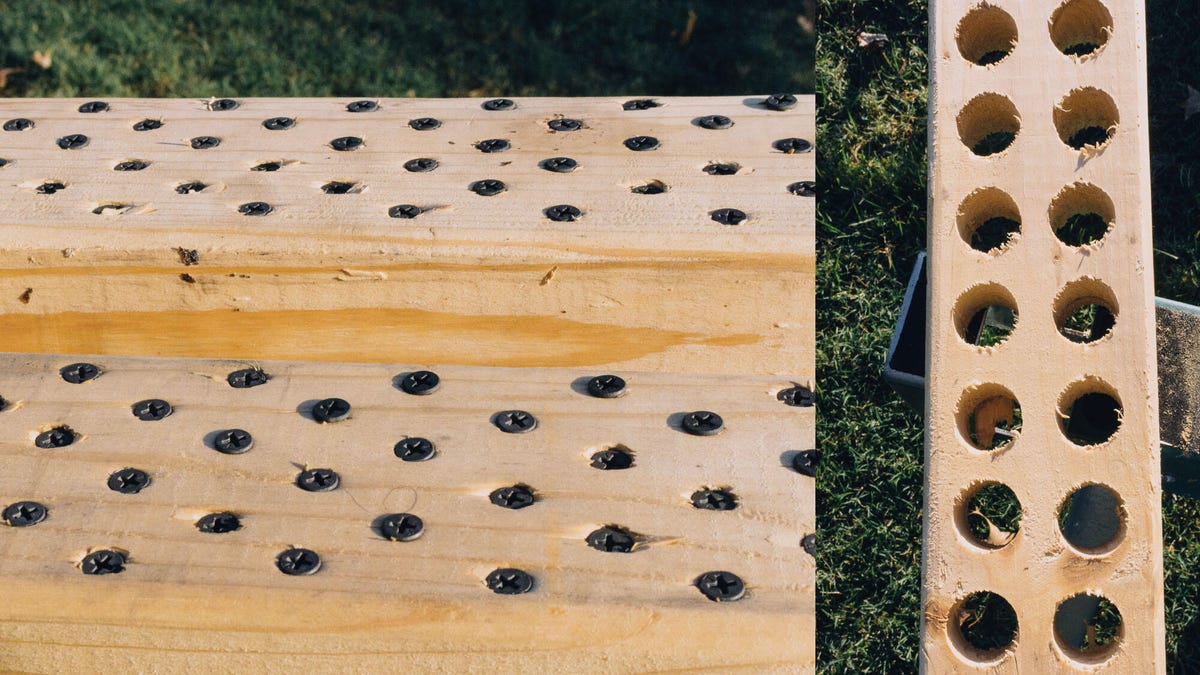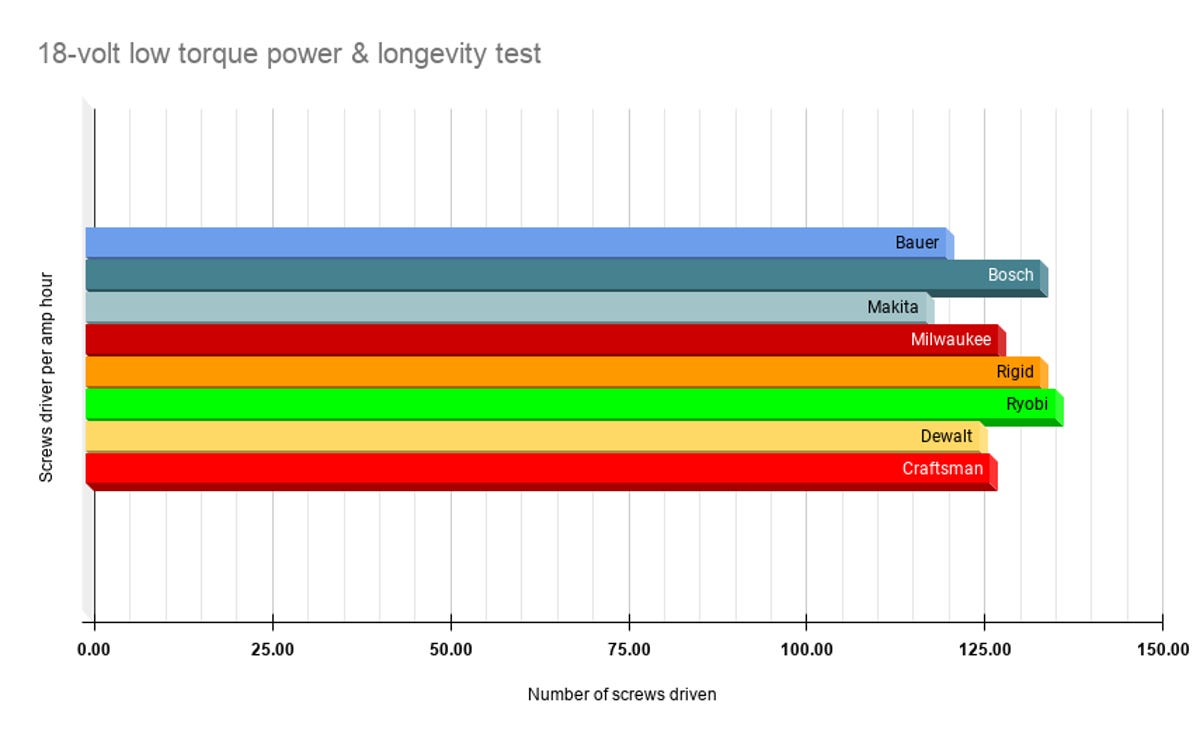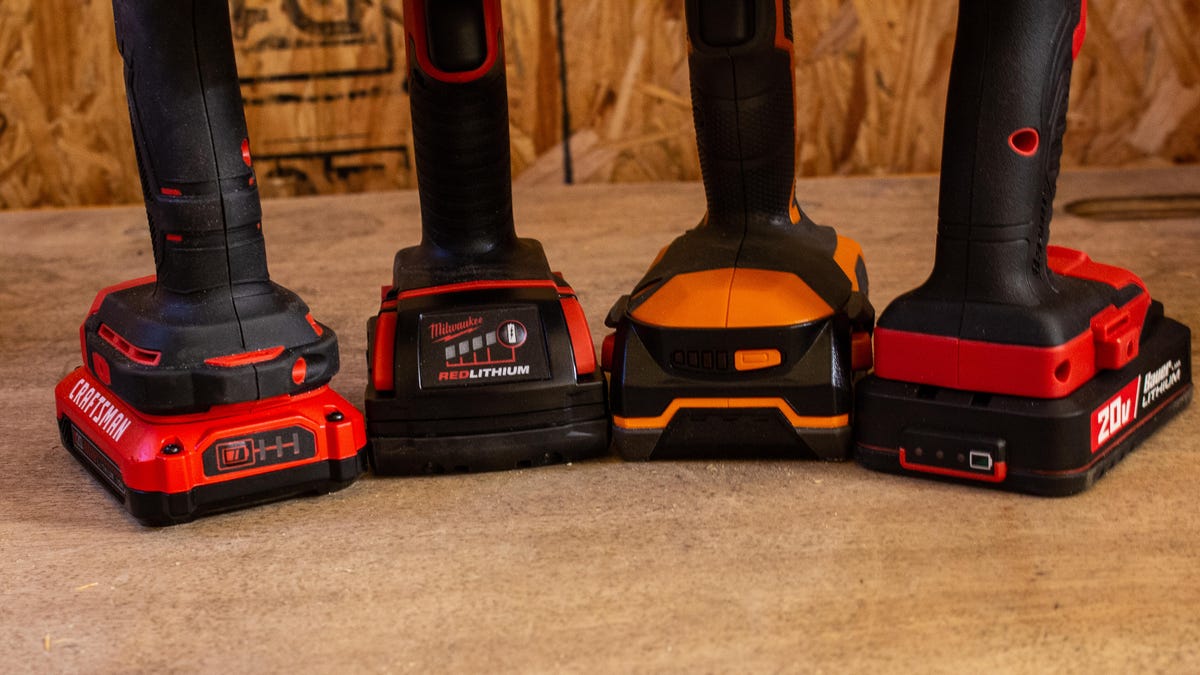
Other than general use and impressions, I have three main ways of testing drills. There’s a clearance test, where I determine the tightest space the drill can get into and still drive or drill at a perfect 90-degree angle perpendicular to the drilling surface. Then there are two different types of power/longevity tests; one with a high torque load and one with a lower load.

Examples of the battery/torque testing process for 12-volt brushed cordless drills.
For the high-torque test, I use a new 1-inch wood spade bit for each drill. I use the bit to drill a series of holes into standard yellow pine construction-grade lumber. After, I divide the number of holes drilled by the battery capacity which gives a “holes per amp hour” data point for comparison. I like this particular metric method because it negates the ability of a drill to win just by having a larger battery.
On this test, the numbers for the 12-volt drills are pretty low — so if you’re looking to bore a lot of holes, it’s probably best to stick with the 18-volt drills. For the most part, all of the 18-volt drills felt strong starting this test off with a new battery, and although it did score second-to-last here, the Ryobi felt the strongest out of the gate. There’s also the breakthrough feel — how well the spade bits are able to exit the opposite side of the lumber without snagging and seizing. Here, it was Milwaukee that really showed off. Not only did Milwaukee absolutely trounce the competition, but the spade bit moved from one side of the lumber to the other with almost no snags. On the opposite end of the scale, both Bosch and Ridgid seemed to have trouble exiting the boards almost every single time.

Number of holes bored per amp hour for 18-volt brushed drills.

Number of holes drilled per amp hour for 12-volt brushed drills.
In the low-torque tests I took some screws — a ton of screws — and drove them into standard four-by-four construction lumber. Drive in as many as possible until the drill can no longer completely seat a screw; i.e. flush or slightly below flush with the lumber, then count. I use the same previously described method here, dividing by amp hour to get our final metric. The original tests for 12-volt drills used #8 2 1/2-inch screws, and the 18-volt tests use #9 3-inch screws.

Number of screws driven per amp hour for 18-volt brushed drills.

Number of screws driven per amp hour for 12-volt brushed drills.
Running the low-torque tests takes longer than the high-torque tests, so there’s more time to get the feel of the tools themselves. Generally speaking, the drills all feel like you’d expect, but there were a couple of features that stood out. On the 18-volt DeWalt, the hand grip feels small. This may actually be a benefit for some people, but for me, it was a little off-putting. I was also not a fan of the trigger on the 18-volt Ridgid. It felt like I had to pull the trigger farther back to reach max power than on other drills. This, over time, leads to a little extra hand cramping. Not ideal if you’re planning on using it for hours at a time.
For the clearance test, I measured the distance from the center of the drill chuck opening to the top of the drill and separately to the side of the drill. The lowest value for each drill you will see is charted below. I converted the measurements to decimals for purposes of the chart, but I did measure these in 1/64-inch increments. The lower the value, the smaller the overall size of the drill is, allowing it to be used in tighter spaces than the drills with larger values.

Clearance results for 18-volt brushed drills.

Clearance results for 12-volt brushed drills.
There were a couple of other features worth pointing out that may help if you’re still undecided. Most drills now come with LED lighting to help with visibility in lower lighting settings. These typically activate once you pull the trigger and go off either when you release the trigger or with a small delay. The placement of the LED is either at the base of the tool near the battery, or above the trigger on the main barrel of the tool. I prefer the placement near the battery. The LED light on the barrel creates a hard shadow line above the midpoint of the chuck, while the lower-placed LED offers more available light above the tool — ideal if you’re in a position where you’re looking down at the tool, and not holding it above your sight line. In 18-volt drills, Bauer, Ryobi and Bosch all have the lower-placed LED, and Ridgid is the only model without an LED light.
Battery life indicators can help out when you find yourself in places where switching out batteries isn’t convenient, say, on a ladder, roof or any other less accessible location. One push of the button and you get an estimate of battery power remaining — usually in 25% increments. Bauer, Ridgid, Milwaukee and Craftsman 18-volt drills all have this feature.

18-volt drill battery life indicators.
Another feature, which may not necessarily be a decision-maker for you, is the battery-release mechanism. The front tab has become the standard and works better on some models than others. All of the battery-powered tools I own personally are front-tabs but I’ve grown to really like the side-tab release. It has a more natural feel and tends to be an easier release as well. In the 18-volt drills listed, Ridgid, Milwaukee and Ryobi all have side tab releases. For me, Ridgid’s design feels the most comfortable.
There’s a larger performance variance in 12-volt drills than I expected and probably less of one at the 18-volt level. If you’re in the market, just make sure you have a clear idea of what exactly you’re hoping to get out of your drill, then take a look at the information provided here. It should be easy enough to get a clear picture of performance, price and capabilities to make sure you end up with the best cordless drill for your needs.